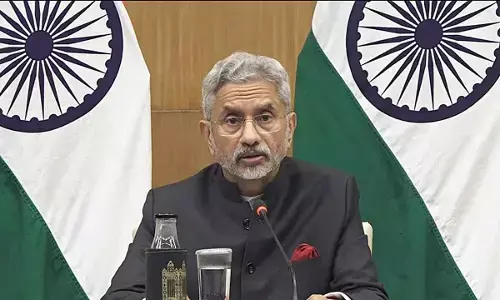Climate change turning AP & Telangana into deserts

Climate Change Turning AP & Telangana Into Deserts. According to the government’s fifth national report on desertification, land degradation and drought, a quarter of India’s land mass is now experiencing desertification as 32 per cent is suffering significant degradation due to heightening dryness and erosion.
 According to the government’s fifth national report on desertification, land degradation and drought, a quarter of India’s land mass is now experiencing desertification as 32 per cent is suffering significant degradation due to heightening dryness and erosion. This amounts to more than 80 million hectares of land facing desertification while more than 100 million hectares are steadily degrading. The report also noted that areas vulnerable to drought had expanded to cover 68 per cent of the Indian subcontinent.
According to the government’s fifth national report on desertification, land degradation and drought, a quarter of India’s land mass is now experiencing desertification as 32 per cent is suffering significant degradation due to heightening dryness and erosion. This amounts to more than 80 million hectares of land facing desertification while more than 100 million hectares are steadily degrading. The report also noted that areas vulnerable to drought had expanded to cover 68 per cent of the Indian subcontinent.
“The degradation was a result of loss of vegetation due to deforestation, chopping trees beyond permissible limits for unsustainable fuels wood and fodder extraction, shifting cultivation, encroachment on forest lands, forest fires and overgrazing,” stated the report - jointly prepared by the environment ministry and the Indian Council of Forestry Research and Education (ICFRE).
The report went on to add that other factors leading to large-scale degradation comprised extension of cultivation to lands of low potential or high natural hazards, non-adoption of adequate soil conservation measures, improper crop rotation, indiscriminate use of agro-chemicals, improper planning and management of irrigation systems and excessive extraction of groundwater.
The rains that have come so far have been feeble. By June 18, precipitation totals were more than 50 per cent below the typical amount for northern and central India and 45 per cent below average for the country as a whole. As for the Pacific Ocean conditions continuing to trend toward El Nino, there is concern that this year’s already diminished rains would snuff out entirely by mid-to-late summer, leaving an already drought-wrecked country with even less water than before.
The report bears out these observations in stark detail-- The yearly monsoon that delivers 80 per cent of India’s rains has fallen in intensity by more than 10 per cent since 1951. And though a 10 per cent loss may seem relatively minor, year on year, the effects are cumulative. Overall, the prevalence of dry years increased from 1981 to 2011 by 27 per cent and the number of years experiencing three or more dry spells doubled.
Much of Telangana is semi-arid with predominantly rain-fed agriculture. The Indian Meteorological Department’s district-wise annual rainfall data for 2012 shows that the districts of Telangana are not the driest in the State. For instance, though Mahbubnagar, Nalgonda, Hyderabad and Rangareddy districts received low rainfall — between 630 and 790 mm — they were not the driest areas. That distinction goes to Anantapur (536 mm) and Kadapa (558.2 mm) districts in Seemandhra.
Even if the annual rainfall for the 10 Telangana districts is averaged out against the 13 Seemandhra districts, the difference is marginal. On average, rainfall in a single Telangana district was 948.8 mm, and in a Seemandhra district, 1068.1 mm.
“North coastal Andhra and some parts of Telangana and Rayalaseema would have a deficit. The main problem is not the deficit but erratic rains. Rainfall would not occur at places that need it the most. According to preliminary predictions, we would have a long break and then a heavy downfall for a week. Global warming is creating a disturbance in the monsoon cycle. We see that monsoon usually extending into October, when it used to end by September,” said SSVS Ramakrishna, professor at the Meteorological Department and chairman at Andhra University.
The silver lining in this dismal scenario is the National Action Plan on Climate Change, launched in 2008, which aims at developing technologies to help rain-fed agriculture adapt to the changing climate patterns. The ICAR-led national agricultural research system is also conducting continuous research on specific projects under the umbrella programme on climate change.










